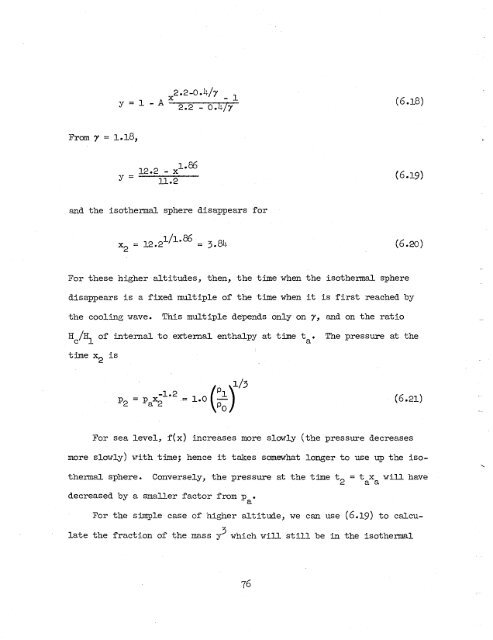Theory of the Fireball
Theory of the Fireball
Theory of the Fireball
You also want an ePaper? Increase the reach of your titles
YUMPU automatically turns print PDFs into web optimized ePapers that Google loves.
From y = 1.18,<br />
y=l-A<br />
Y=<br />
-1<br />
2.2 - 0*4/y<br />
X 2.2-0.4/y<br />
12.2 - x<br />
1-85<br />
11.2<br />
and <strong>the</strong> iso<strong>the</strong>rmal sphere disappears for<br />
l/1 . e6<br />
x = 12.2 = 3.811-<br />
2<br />
For <strong>the</strong>se higher altitudes, <strong>the</strong>n, <strong>the</strong> time when <strong>the</strong> iso<strong>the</strong>rmal sphere<br />
(6 -18)<br />
(6.20)<br />
disappears is a fixed multiple <strong>of</strong> <strong>the</strong> time when it is first reached by<br />
<strong>the</strong> cooling wave. This multiple depends only on y, and on <strong>the</strong> ratio<br />
Hc/Hl <strong>of</strong> internal to external ent'nalpy at time ta. Tne pressure at <strong>the</strong><br />
time x is<br />
2<br />
1/3<br />
-1.2<br />
P2 = PaX2 .= 1.0 ($) (6.21)<br />
For sea level, f (x) increases more slovly (<strong>the</strong> pressure decreases<br />
more slovly) with time; hence it takes somewhat longer to use q <strong>the</strong> iso-<br />
tnemal sphere. Conversely, t'ne pressure at <strong>the</strong> time t = t x will have<br />
2 aa<br />
decreased by a smaller factor from pa.<br />
For <strong>the</strong> simple case <strong>of</strong> nigher altitude, we can use (6.19) to calcu-<br />
late <strong>the</strong> fraction <strong>of</strong> <strong>the</strong> mass y 3 which -<br />
will still be in <strong>the</strong> iso<strong>the</strong>rmal
















